Acceptance of Webinars for Professional Development Purposes
VerifiedAdded on 2023/06/15
|13
|3689
|265
AI Summary
This proposed quantitative study investigates faculty members’ behavioral intention towards the use of webinars for professional development purposes in the Institute of Public Administration (IPA) in Saudi Arabia based on the Technology Acceptance Model (TAM). The study aims to address the challenges of using webinars as a professional development tool and to determine the level of acceptance of webinars among faculty members. The theoretical framework that guides the proposed study is the Technology Acceptance Model (TAM).
Contribute Materials
Your contribution can guide someone’s learning journey. Share your
documents today.
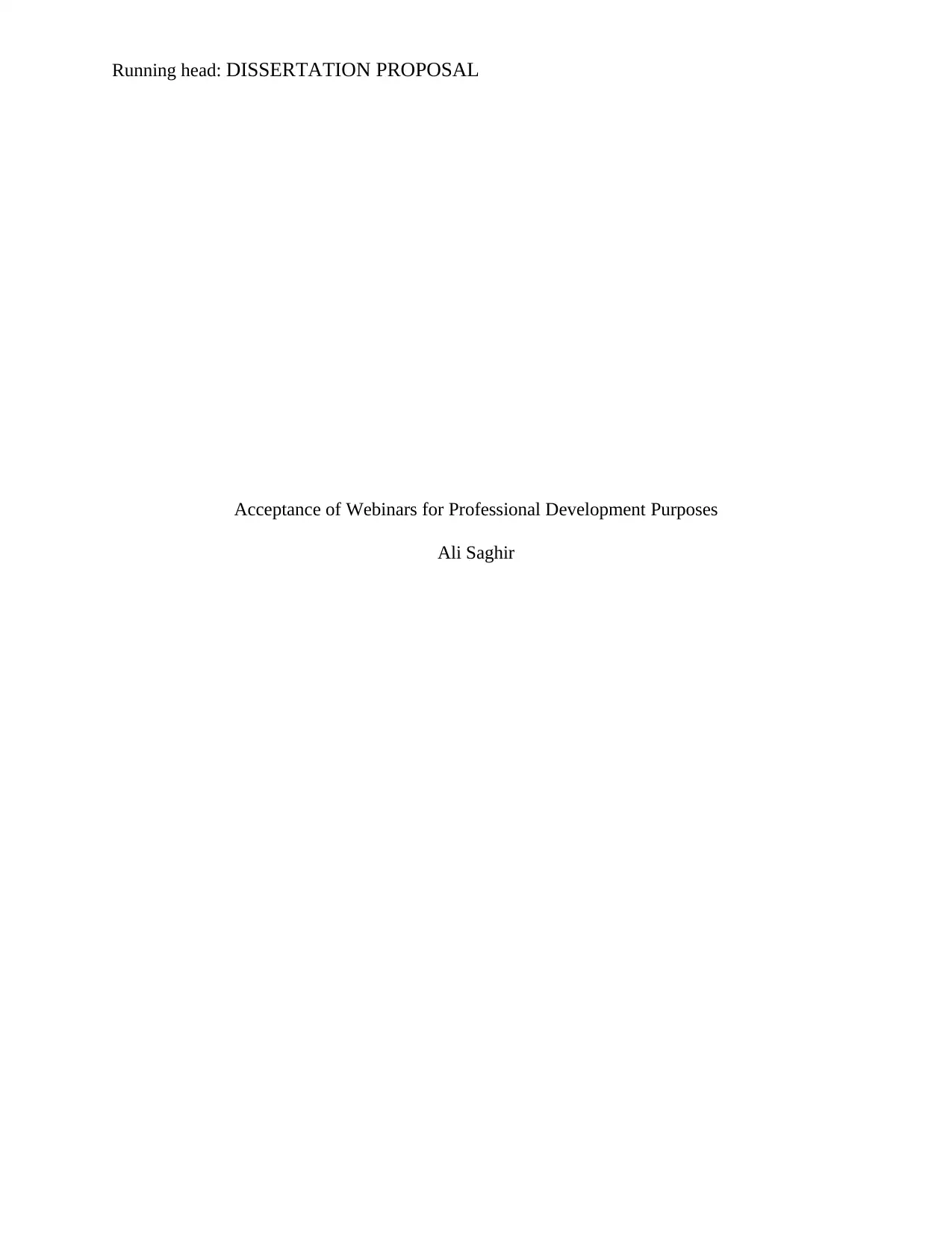
Running head: DISSERTATION PROPOSAL
Acceptance of Webinars for Professional Development Purposes
Ali Saghir
Acceptance of Webinars for Professional Development Purposes
Ali Saghir
Secure Best Marks with AI Grader
Need help grading? Try our AI Grader for instant feedback on your assignments.

DISSERTATION PROPOSAL
CHAPTER 1
INTRODUCTION TO THE STUDY
Introduction
Research on professional development has contributed to our understanding of how
teachers learn and improve their practice through PD. According to Vu, Cao, Vu and Cepero
(2014), professional development is the process of learning and ensuring that one's area of
expertise is kept up-to-date, both for career advancement and personal development. Individuals
that are interested in professional development are usually inclined to improve their ability and
strengths as well as enhancing their work in terms of lifelong learning. Persellin and Goodrick
(2010) explain that faculty development includes teachers' training, which most of the time is
considered pre-service. However, in most instances, faculty professional development involves
on-going learning for the professional educators. The learning may be in-service, or it may take
place out of work. Lancaster, Stein, MacLean, Van Amburgh, and Persky (2014) illustrate that
faculty development programs in various institutions vary in regard to the function and structure.
Professional development might be a key to success to the faculty members who teach online.
Faculty members who have had little to no online experiences are often asked to teach online and
they are faced with the challenge of converting their traditional courses to the online formats
(Bousbahi&Alrazgan, 2015). When planning for the faculty development, organizations should
also take into the consideration the unique elements which are associated to the online
environment. According to Shahdad & Shirazin, (2012) highlighted that strategies that are used
to prepare instructors to teach online substantively vary from the strategies which are used for
teaching face to face.
2
CHAPTER 1
INTRODUCTION TO THE STUDY
Introduction
Research on professional development has contributed to our understanding of how
teachers learn and improve their practice through PD. According to Vu, Cao, Vu and Cepero
(2014), professional development is the process of learning and ensuring that one's area of
expertise is kept up-to-date, both for career advancement and personal development. Individuals
that are interested in professional development are usually inclined to improve their ability and
strengths as well as enhancing their work in terms of lifelong learning. Persellin and Goodrick
(2010) explain that faculty development includes teachers' training, which most of the time is
considered pre-service. However, in most instances, faculty professional development involves
on-going learning for the professional educators. The learning may be in-service, or it may take
place out of work. Lancaster, Stein, MacLean, Van Amburgh, and Persky (2014) illustrate that
faculty development programs in various institutions vary in regard to the function and structure.
Professional development might be a key to success to the faculty members who teach online.
Faculty members who have had little to no online experiences are often asked to teach online and
they are faced with the challenge of converting their traditional courses to the online formats
(Bousbahi&Alrazgan, 2015). When planning for the faculty development, organizations should
also take into the consideration the unique elements which are associated to the online
environment. According to Shahdad & Shirazin, (2012) highlighted that strategies that are used
to prepare instructors to teach online substantively vary from the strategies which are used for
teaching face to face.
2
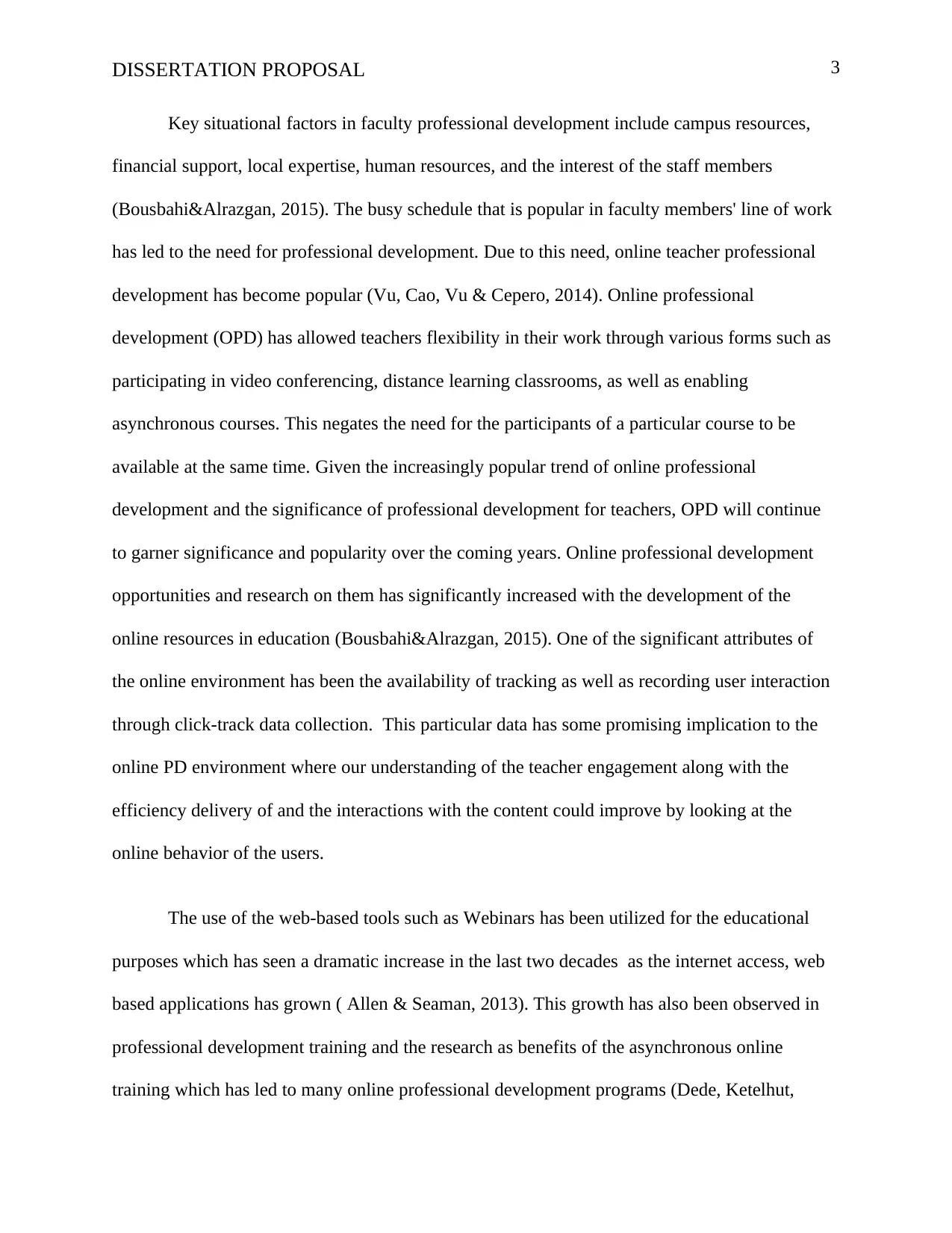
DISSERTATION PROPOSAL
Key situational factors in faculty professional development include campus resources,
financial support, local expertise, human resources, and the interest of the staff members
(Bousbahi&Alrazgan, 2015). The busy schedule that is popular in faculty members' line of work
has led to the need for professional development. Due to this need, online teacher professional
development has become popular (Vu, Cao, Vu & Cepero, 2014). Online professional
development (OPD) has allowed teachers flexibility in their work through various forms such as
participating in video conferencing, distance learning classrooms, as well as enabling
asynchronous courses. This negates the need for the participants of a particular course to be
available at the same time. Given the increasingly popular trend of online professional
development and the significance of professional development for teachers, OPD will continue
to garner significance and popularity over the coming years. Online professional development
opportunities and research on them has significantly increased with the development of the
online resources in education (Bousbahi&Alrazgan, 2015). One of the significant attributes of
the online environment has been the availability of tracking as well as recording user interaction
through click-track data collection. This particular data has some promising implication to the
online PD environment where our understanding of the teacher engagement along with the
efficiency delivery of and the interactions with the content could improve by looking at the
online behavior of the users.
The use of the web-based tools such as Webinars has been utilized for the educational
purposes which has seen a dramatic increase in the last two decades as the internet access, web
based applications has grown ( Allen & Seaman, 2013). This growth has also been observed in
professional development training and the research as benefits of the asynchronous online
training which has led to many online professional development programs (Dede, Ketelhut,
3
Key situational factors in faculty professional development include campus resources,
financial support, local expertise, human resources, and the interest of the staff members
(Bousbahi&Alrazgan, 2015). The busy schedule that is popular in faculty members' line of work
has led to the need for professional development. Due to this need, online teacher professional
development has become popular (Vu, Cao, Vu & Cepero, 2014). Online professional
development (OPD) has allowed teachers flexibility in their work through various forms such as
participating in video conferencing, distance learning classrooms, as well as enabling
asynchronous courses. This negates the need for the participants of a particular course to be
available at the same time. Given the increasingly popular trend of online professional
development and the significance of professional development for teachers, OPD will continue
to garner significance and popularity over the coming years. Online professional development
opportunities and research on them has significantly increased with the development of the
online resources in education (Bousbahi&Alrazgan, 2015). One of the significant attributes of
the online environment has been the availability of tracking as well as recording user interaction
through click-track data collection. This particular data has some promising implication to the
online PD environment where our understanding of the teacher engagement along with the
efficiency delivery of and the interactions with the content could improve by looking at the
online behavior of the users.
The use of the web-based tools such as Webinars has been utilized for the educational
purposes which has seen a dramatic increase in the last two decades as the internet access, web
based applications has grown ( Allen & Seaman, 2013). This growth has also been observed in
professional development training and the research as benefits of the asynchronous online
training which has led to many online professional development programs (Dede, Ketelhut,
3
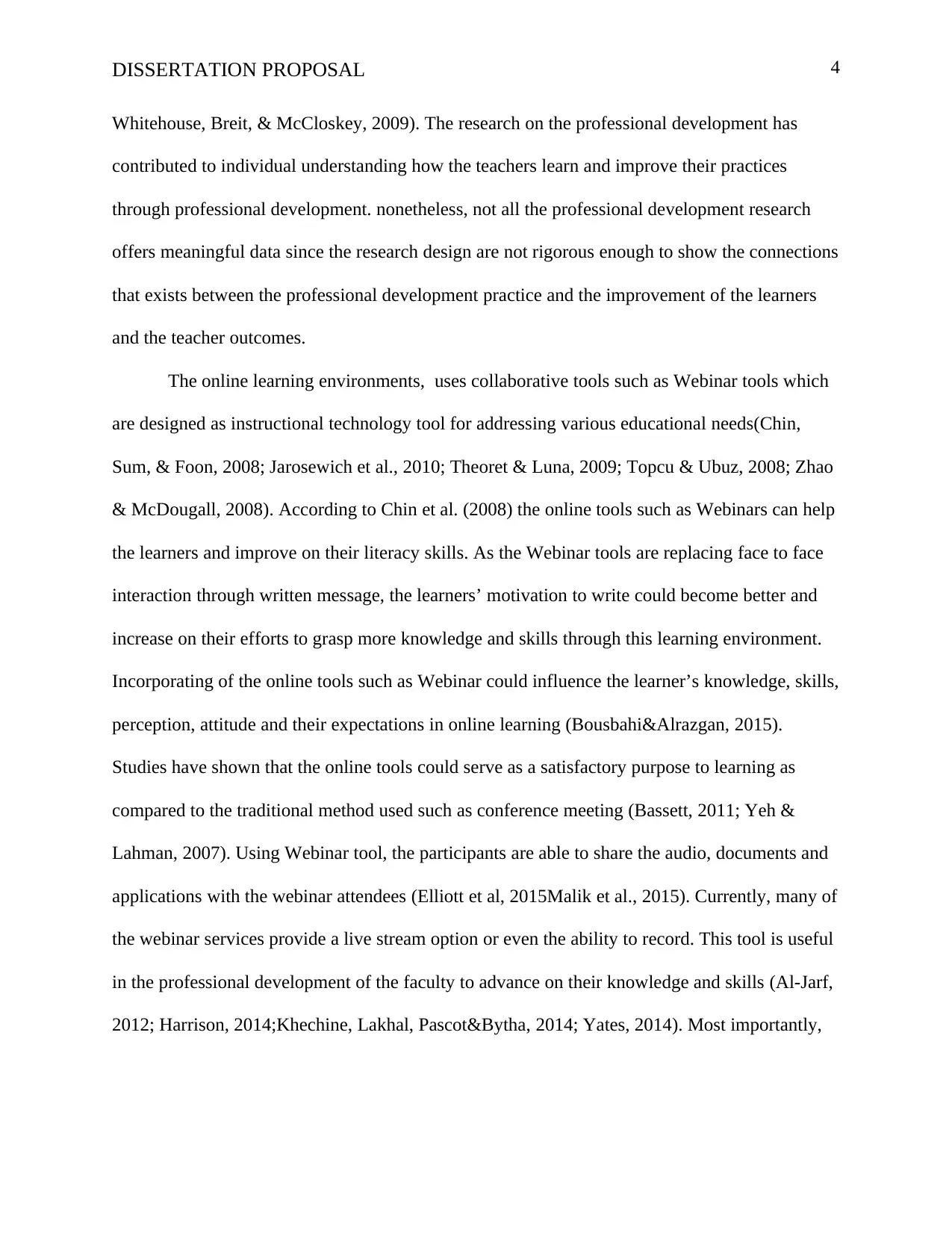
DISSERTATION PROPOSAL
Whitehouse, Breit, & McCloskey, 2009). The research on the professional development has
contributed to individual understanding how the teachers learn and improve their practices
through professional development. nonetheless, not all the professional development research
offers meaningful data since the research design are not rigorous enough to show the connections
that exists between the professional development practice and the improvement of the learners
and the teacher outcomes.
The online learning environments, uses collaborative tools such as Webinar tools which
are designed as instructional technology tool for addressing various educational needs(Chin,
Sum, & Foon, 2008; Jarosewich et al., 2010; Theoret & Luna, 2009; Topcu & Ubuz, 2008; Zhao
& McDougall, 2008). According to Chin et al. (2008) the online tools such as Webinars can help
the learners and improve on their literacy skills. As the Webinar tools are replacing face to face
interaction through written message, the learners’ motivation to write could become better and
increase on their efforts to grasp more knowledge and skills through this learning environment.
Incorporating of the online tools such as Webinar could influence the learner’s knowledge, skills,
perception, attitude and their expectations in online learning (Bousbahi&Alrazgan, 2015).
Studies have shown that the online tools could serve as a satisfactory purpose to learning as
compared to the traditional method used such as conference meeting (Bassett, 2011; Yeh &
Lahman, 2007). Using Webinar tool, the participants are able to share the audio, documents and
applications with the webinar attendees (Elliott et al, 2015Malik et al., 2015). Currently, many of
the webinar services provide a live stream option or even the ability to record. This tool is useful
in the professional development of the faculty to advance on their knowledge and skills (Al-Jarf,
2012; Harrison, 2014;Khechine, Lakhal, Pascot&Bytha, 2014; Yates, 2014). Most importantly,
4
Whitehouse, Breit, & McCloskey, 2009). The research on the professional development has
contributed to individual understanding how the teachers learn and improve their practices
through professional development. nonetheless, not all the professional development research
offers meaningful data since the research design are not rigorous enough to show the connections
that exists between the professional development practice and the improvement of the learners
and the teacher outcomes.
The online learning environments, uses collaborative tools such as Webinar tools which
are designed as instructional technology tool for addressing various educational needs(Chin,
Sum, & Foon, 2008; Jarosewich et al., 2010; Theoret & Luna, 2009; Topcu & Ubuz, 2008; Zhao
& McDougall, 2008). According to Chin et al. (2008) the online tools such as Webinars can help
the learners and improve on their literacy skills. As the Webinar tools are replacing face to face
interaction through written message, the learners’ motivation to write could become better and
increase on their efforts to grasp more knowledge and skills through this learning environment.
Incorporating of the online tools such as Webinar could influence the learner’s knowledge, skills,
perception, attitude and their expectations in online learning (Bousbahi&Alrazgan, 2015).
Studies have shown that the online tools could serve as a satisfactory purpose to learning as
compared to the traditional method used such as conference meeting (Bassett, 2011; Yeh &
Lahman, 2007). Using Webinar tool, the participants are able to share the audio, documents and
applications with the webinar attendees (Elliott et al, 2015Malik et al., 2015). Currently, many of
the webinar services provide a live stream option or even the ability to record. This tool is useful
in the professional development of the faculty to advance on their knowledge and skills (Al-Jarf,
2012; Harrison, 2014;Khechine, Lakhal, Pascot&Bytha, 2014; Yates, 2014). Most importantly,
4
Secure Best Marks with AI Grader
Need help grading? Try our AI Grader for instant feedback on your assignments.
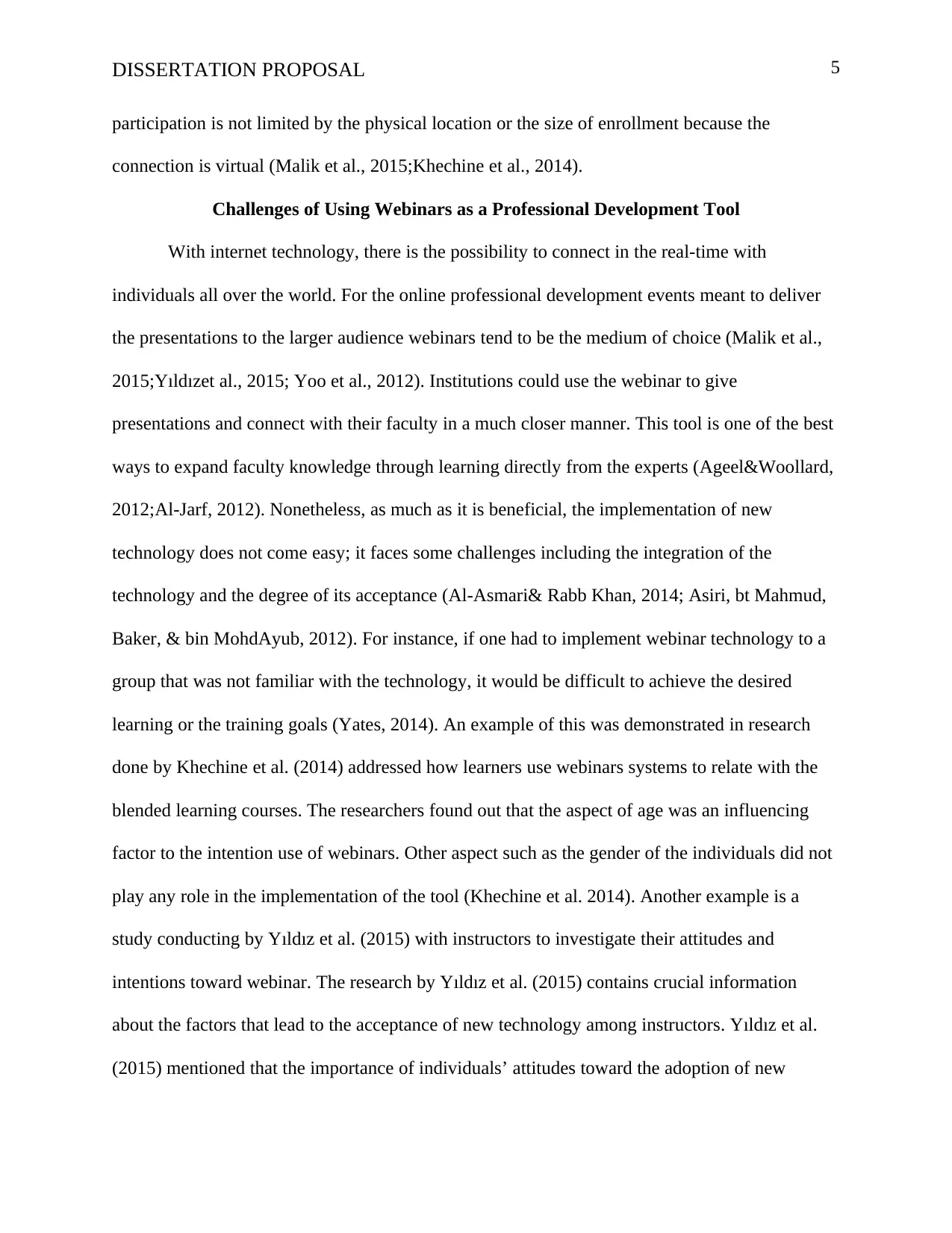
DISSERTATION PROPOSAL
participation is not limited by the physical location or the size of enrollment because the
connection is virtual (Malik et al., 2015;Khechine et al., 2014).
Challenges of Using Webinars as a Professional Development Tool
With internet technology, there is the possibility to connect in the real-time with
individuals all over the world. For the online professional development events meant to deliver
the presentations to the larger audience webinars tend to be the medium of choice (Malik et al.,
2015;Yıldızet al., 2015; Yoo et al., 2012). Institutions could use the webinar to give
presentations and connect with their faculty in a much closer manner. This tool is one of the best
ways to expand faculty knowledge through learning directly from the experts (Ageel&Woollard,
2012;Al-Jarf, 2012). Nonetheless, as much as it is beneficial, the implementation of new
technology does not come easy; it faces some challenges including the integration of the
technology and the degree of its acceptance (Al-Asmari& Rabb Khan, 2014; Asiri, bt Mahmud,
Baker, & bin MohdAyub, 2012). For instance, if one had to implement webinar technology to a
group that was not familiar with the technology, it would be difficult to achieve the desired
learning or the training goals (Yates, 2014). An example of this was demonstrated in research
done by Khechine et al. (2014) addressed how learners use webinars systems to relate with the
blended learning courses. The researchers found out that the aspect of age was an influencing
factor to the intention use of webinars. Other aspect such as the gender of the individuals did not
play any role in the implementation of the tool (Khechine et al. 2014). Another example is a
study conducting by Yıldız et al. (2015) with instructors to investigate their attitudes and
intentions toward webinar. The research by Yıldız et al. (2015) contains crucial information
about the factors that lead to the acceptance of new technology among instructors. Yıldız et al.
(2015) mentioned that the importance of individuals’ attitudes toward the adoption of new
5
participation is not limited by the physical location or the size of enrollment because the
connection is virtual (Malik et al., 2015;Khechine et al., 2014).
Challenges of Using Webinars as a Professional Development Tool
With internet technology, there is the possibility to connect in the real-time with
individuals all over the world. For the online professional development events meant to deliver
the presentations to the larger audience webinars tend to be the medium of choice (Malik et al.,
2015;Yıldızet al., 2015; Yoo et al., 2012). Institutions could use the webinar to give
presentations and connect with their faculty in a much closer manner. This tool is one of the best
ways to expand faculty knowledge through learning directly from the experts (Ageel&Woollard,
2012;Al-Jarf, 2012). Nonetheless, as much as it is beneficial, the implementation of new
technology does not come easy; it faces some challenges including the integration of the
technology and the degree of its acceptance (Al-Asmari& Rabb Khan, 2014; Asiri, bt Mahmud,
Baker, & bin MohdAyub, 2012). For instance, if one had to implement webinar technology to a
group that was not familiar with the technology, it would be difficult to achieve the desired
learning or the training goals (Yates, 2014). An example of this was demonstrated in research
done by Khechine et al. (2014) addressed how learners use webinars systems to relate with the
blended learning courses. The researchers found out that the aspect of age was an influencing
factor to the intention use of webinars. Other aspect such as the gender of the individuals did not
play any role in the implementation of the tool (Khechine et al. 2014). Another example is a
study conducting by Yıldız et al. (2015) with instructors to investigate their attitudes and
intentions toward webinar. The research by Yıldız et al. (2015) contains crucial information
about the factors that lead to the acceptance of new technology among instructors. Yıldız et al.
(2015) mentioned that the importance of individuals’ attitudes toward the adoption of new
5
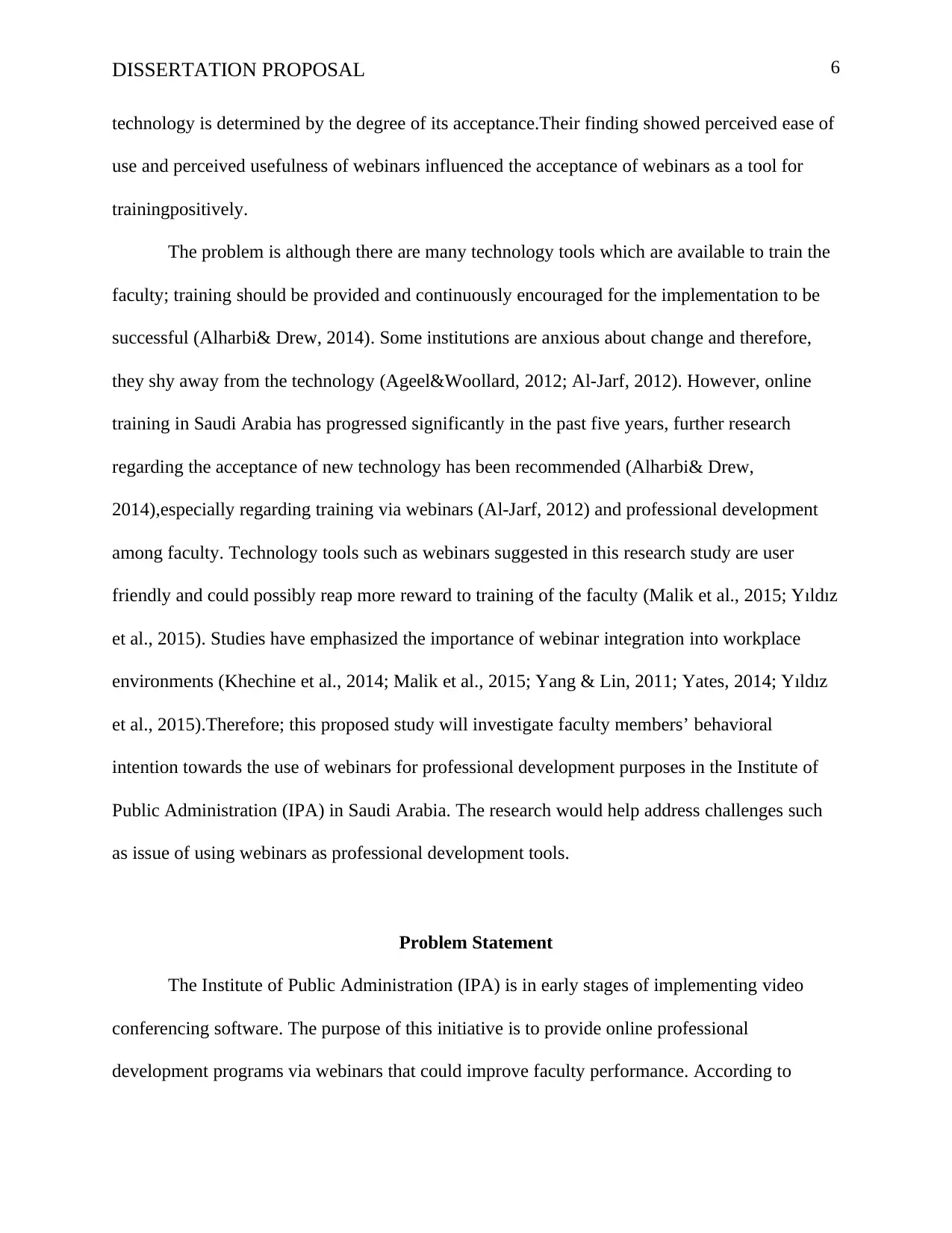
DISSERTATION PROPOSAL
technology is determined by the degree of its acceptance.Their finding showed perceived ease of
use and perceived usefulness of webinars influenced the acceptance of webinars as a tool for
trainingpositively.
The problem is although there are many technology tools which are available to train the
faculty; training should be provided and continuously encouraged for the implementation to be
successful (Alharbi& Drew, 2014). Some institutions are anxious about change and therefore,
they shy away from the technology (Ageel&Woollard, 2012; Al-Jarf, 2012). However, online
training in Saudi Arabia has progressed significantly in the past five years, further research
regarding the acceptance of new technology has been recommended (Alharbi& Drew,
2014),especially regarding training via webinars (Al-Jarf, 2012) and professional development
among faculty. Technology tools such as webinars suggested in this research study are user
friendly and could possibly reap more reward to training of the faculty (Malik et al., 2015; Yıldız
et al., 2015). Studies have emphasized the importance of webinar integration into workplace
environments (Khechine et al., 2014; Malik et al., 2015; Yang & Lin, 2011; Yates, 2014; Yıldız
et al., 2015).Therefore; this proposed study will investigate faculty members’ behavioral
intention towards the use of webinars for professional development purposes in the Institute of
Public Administration (IPA) in Saudi Arabia. The research would help address challenges such
as issue of using webinars as professional development tools.
Problem Statement
The Institute of Public Administration (IPA) is in early stages of implementing video
conferencing software. The purpose of this initiative is to provide online professional
development programs via webinars that could improve faculty performance. According to
6
technology is determined by the degree of its acceptance.Their finding showed perceived ease of
use and perceived usefulness of webinars influenced the acceptance of webinars as a tool for
trainingpositively.
The problem is although there are many technology tools which are available to train the
faculty; training should be provided and continuously encouraged for the implementation to be
successful (Alharbi& Drew, 2014). Some institutions are anxious about change and therefore,
they shy away from the technology (Ageel&Woollard, 2012; Al-Jarf, 2012). However, online
training in Saudi Arabia has progressed significantly in the past five years, further research
regarding the acceptance of new technology has been recommended (Alharbi& Drew,
2014),especially regarding training via webinars (Al-Jarf, 2012) and professional development
among faculty. Technology tools such as webinars suggested in this research study are user
friendly and could possibly reap more reward to training of the faculty (Malik et al., 2015; Yıldız
et al., 2015). Studies have emphasized the importance of webinar integration into workplace
environments (Khechine et al., 2014; Malik et al., 2015; Yang & Lin, 2011; Yates, 2014; Yıldız
et al., 2015).Therefore; this proposed study will investigate faculty members’ behavioral
intention towards the use of webinars for professional development purposes in the Institute of
Public Administration (IPA) in Saudi Arabia. The research would help address challenges such
as issue of using webinars as professional development tools.
Problem Statement
The Institute of Public Administration (IPA) is in early stages of implementing video
conferencing software. The purpose of this initiative is to provide online professional
development programs via webinars that could improve faculty performance. According to
6
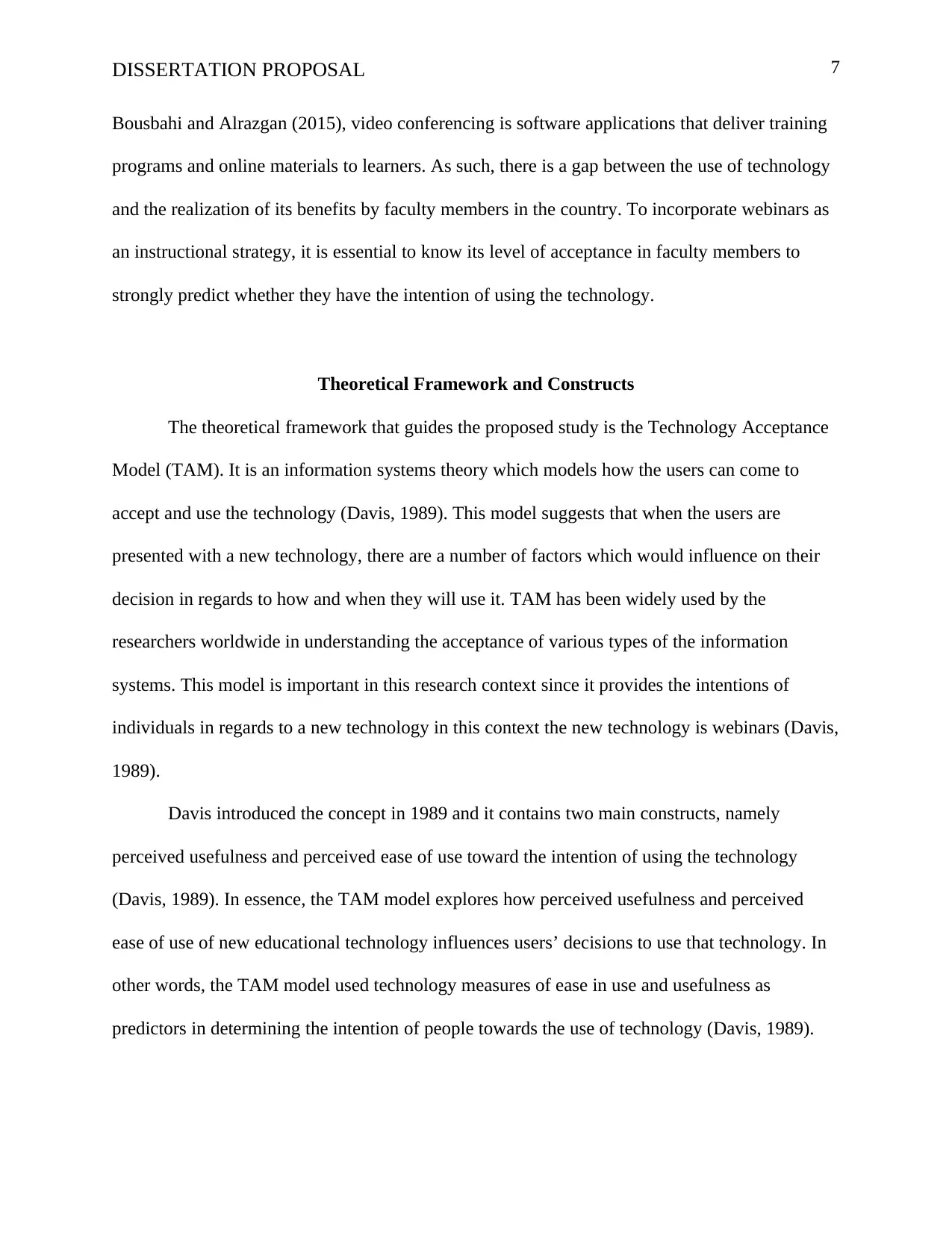
DISSERTATION PROPOSAL
Bousbahi and Alrazgan (2015), video conferencing is software applications that deliver training
programs and online materials to learners. As such, there is a gap between the use of technology
and the realization of its benefits by faculty members in the country. To incorporate webinars as
an instructional strategy, it is essential to know its level of acceptance in faculty members to
strongly predict whether they have the intention of using the technology.
Theoretical Framework and Constructs
The theoretical framework that guides the proposed study is the Technology Acceptance
Model (TAM). It is an information systems theory which models how the users can come to
accept and use the technology (Davis, 1989). This model suggests that when the users are
presented with a new technology, there are a number of factors which would influence on their
decision in regards to how and when they will use it. TAM has been widely used by the
researchers worldwide in understanding the acceptance of various types of the information
systems. This model is important in this research context since it provides the intentions of
individuals in regards to a new technology in this context the new technology is webinars (Davis,
1989).
Davis introduced the concept in 1989 and it contains two main constructs, namely
perceived usefulness and perceived ease of use toward the intention of using the technology
(Davis, 1989). In essence, the TAM model explores how perceived usefulness and perceived
ease of use of new educational technology influences users’ decisions to use that technology. In
other words, the TAM model used technology measures of ease in use and usefulness as
predictors in determining the intention of people towards the use of technology (Davis, 1989).
7
Bousbahi and Alrazgan (2015), video conferencing is software applications that deliver training
programs and online materials to learners. As such, there is a gap between the use of technology
and the realization of its benefits by faculty members in the country. To incorporate webinars as
an instructional strategy, it is essential to know its level of acceptance in faculty members to
strongly predict whether they have the intention of using the technology.
Theoretical Framework and Constructs
The theoretical framework that guides the proposed study is the Technology Acceptance
Model (TAM). It is an information systems theory which models how the users can come to
accept and use the technology (Davis, 1989). This model suggests that when the users are
presented with a new technology, there are a number of factors which would influence on their
decision in regards to how and when they will use it. TAM has been widely used by the
researchers worldwide in understanding the acceptance of various types of the information
systems. This model is important in this research context since it provides the intentions of
individuals in regards to a new technology in this context the new technology is webinars (Davis,
1989).
Davis introduced the concept in 1989 and it contains two main constructs, namely
perceived usefulness and perceived ease of use toward the intention of using the technology
(Davis, 1989). In essence, the TAM model explores how perceived usefulness and perceived
ease of use of new educational technology influences users’ decisions to use that technology. In
other words, the TAM model used technology measures of ease in use and usefulness as
predictors in determining the intention of people towards the use of technology (Davis, 1989).
7
Paraphrase This Document
Need a fresh take? Get an instant paraphrase of this document with our AI Paraphraser

DISSERTATION PROPOSAL
TAM became one of the most widely used ideas to predict the acceptance of a new
technology by individual users (Abu &Yunus, 2014; Alharbi& Drew, 2014). The TAM model
implies that whenever users are offered a new technology, such as webinar- (in this case), there
are numerous aspects that manipulate their decisions concerning how and when they will utilize
it (Alharbi& Drew, 2014). The TAM model could be important in demonstrating how concepts
apply to the acceptance of webinar technology as a training instrument among Institute of Public
Administration (IPA) faculty members in Saudi Arabia. The Technology Acceptance Model can
be used to explain faculty members’ behavioral intention to new technological experiences.
Perceived usefulness: This component refers to whether a user believes that the
technology could meet their needs (Davis, 1989). In this study the new technology is webinars.
Based on this model webinars technology will enhance the job performance of the faculty
members at IPA. Training of the members would be made easy as it is done online and there
would be no need of the trainers to go to the other branches for training since it can be done
online.
Perceived ease of use: This refers to an individual’s view of the user friendliness of a
particular technology (Davis, 1989). The prospective users are expected to use webinars tool
with ease. The IPA might use it to deliver the training to the faculty to help them enhance their
skills and in the long run be more productive. Due to understanding on the use of the technology
it would be much easier for the faculty to adopt and use the technology (Davis, 1989).
Purpose of the Study
The purpose of this proposed quantitative study is to investigate faculty members’
behavioral intention towards the use of webinars for professional development purposes in the
Institute of Public Administration (IPA) in Saudi Arabia based on the Technology
8
TAM became one of the most widely used ideas to predict the acceptance of a new
technology by individual users (Abu &Yunus, 2014; Alharbi& Drew, 2014). The TAM model
implies that whenever users are offered a new technology, such as webinar- (in this case), there
are numerous aspects that manipulate their decisions concerning how and when they will utilize
it (Alharbi& Drew, 2014). The TAM model could be important in demonstrating how concepts
apply to the acceptance of webinar technology as a training instrument among Institute of Public
Administration (IPA) faculty members in Saudi Arabia. The Technology Acceptance Model can
be used to explain faculty members’ behavioral intention to new technological experiences.
Perceived usefulness: This component refers to whether a user believes that the
technology could meet their needs (Davis, 1989). In this study the new technology is webinars.
Based on this model webinars technology will enhance the job performance of the faculty
members at IPA. Training of the members would be made easy as it is done online and there
would be no need of the trainers to go to the other branches for training since it can be done
online.
Perceived ease of use: This refers to an individual’s view of the user friendliness of a
particular technology (Davis, 1989). The prospective users are expected to use webinars tool
with ease. The IPA might use it to deliver the training to the faculty to help them enhance their
skills and in the long run be more productive. Due to understanding on the use of the technology
it would be much easier for the faculty to adopt and use the technology (Davis, 1989).
Purpose of the Study
The purpose of this proposed quantitative study is to investigate faculty members’
behavioral intention towards the use of webinars for professional development purposes in the
Institute of Public Administration (IPA) in Saudi Arabia based on the Technology
8
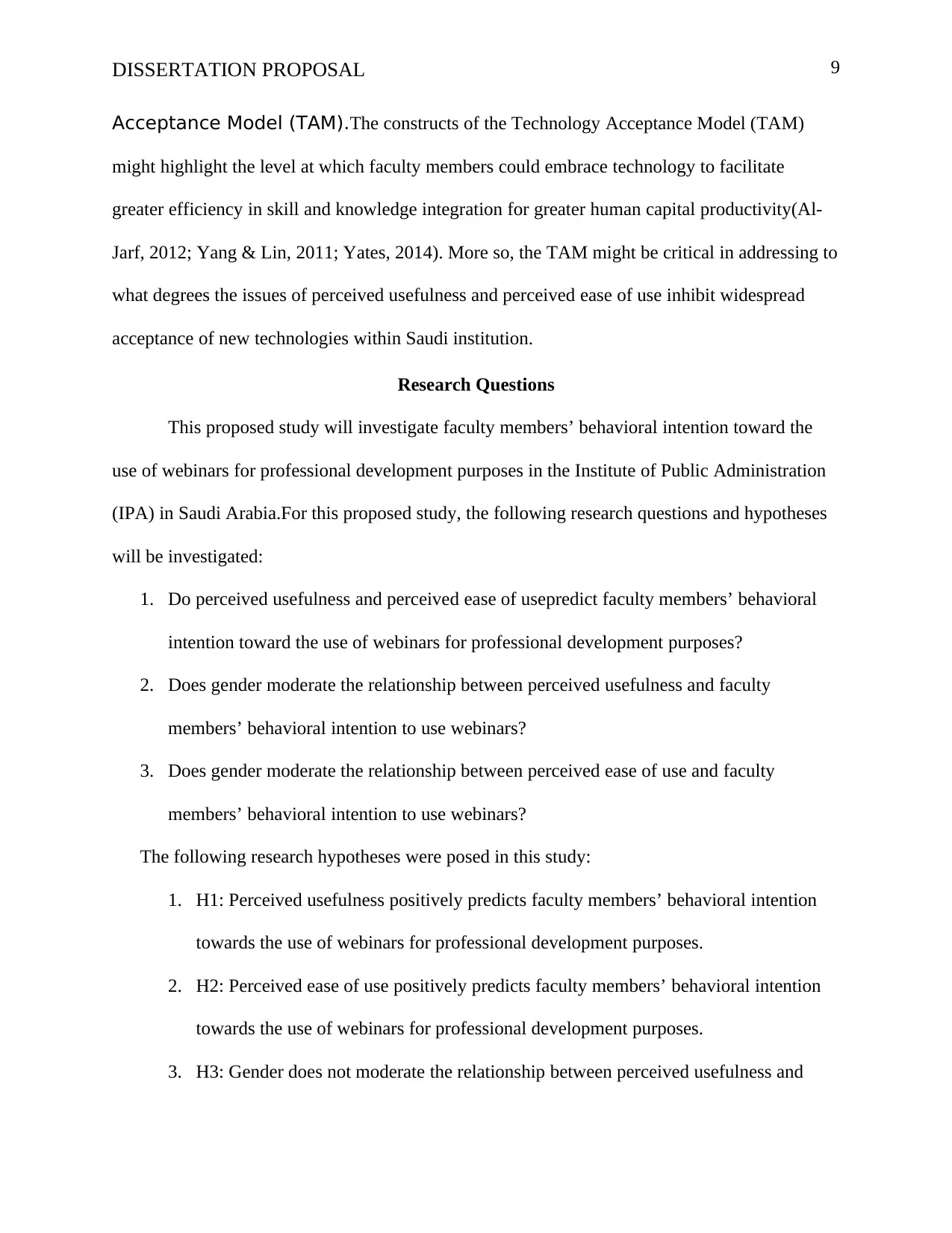
DISSERTATION PROPOSAL
Acceptance Model (TAM).The constructs of the Technology Acceptance Model (TAM)
might highlight the level at which faculty members could embrace technology to facilitate
greater efficiency in skill and knowledge integration for greater human capital productivity(Al-
Jarf, 2012; Yang & Lin, 2011; Yates, 2014). More so, the TAM might be critical in addressing to
what degrees the issues of perceived usefulness and perceived ease of use inhibit widespread
acceptance of new technologies within Saudi institution.
Research Questions
This proposed study will investigate faculty members’ behavioral intention toward the
use of webinars for professional development purposes in the Institute of Public Administration
(IPA) in Saudi Arabia.For this proposed study, the following research questions and hypotheses
will be investigated:
1. Do perceived usefulness and perceived ease of usepredict faculty members’ behavioral
intention toward the use of webinars for professional development purposes?
2. Does gender moderate the relationship between perceived usefulness and faculty
members’ behavioral intention to use webinars?
3. Does gender moderate the relationship between perceived ease of use and faculty
members’ behavioral intention to use webinars?
The following research hypotheses were posed in this study:
1. H1: Perceived usefulness positively predicts faculty members’ behavioral intention
towards the use of webinars for professional development purposes.
2. H2: Perceived ease of use positively predicts faculty members’ behavioral intention
towards the use of webinars for professional development purposes.
3. H3: Gender does not moderate the relationship between perceived usefulness and
9
Acceptance Model (TAM).The constructs of the Technology Acceptance Model (TAM)
might highlight the level at which faculty members could embrace technology to facilitate
greater efficiency in skill and knowledge integration for greater human capital productivity(Al-
Jarf, 2012; Yang & Lin, 2011; Yates, 2014). More so, the TAM might be critical in addressing to
what degrees the issues of perceived usefulness and perceived ease of use inhibit widespread
acceptance of new technologies within Saudi institution.
Research Questions
This proposed study will investigate faculty members’ behavioral intention toward the
use of webinars for professional development purposes in the Institute of Public Administration
(IPA) in Saudi Arabia.For this proposed study, the following research questions and hypotheses
will be investigated:
1. Do perceived usefulness and perceived ease of usepredict faculty members’ behavioral
intention toward the use of webinars for professional development purposes?
2. Does gender moderate the relationship between perceived usefulness and faculty
members’ behavioral intention to use webinars?
3. Does gender moderate the relationship between perceived ease of use and faculty
members’ behavioral intention to use webinars?
The following research hypotheses were posed in this study:
1. H1: Perceived usefulness positively predicts faculty members’ behavioral intention
towards the use of webinars for professional development purposes.
2. H2: Perceived ease of use positively predicts faculty members’ behavioral intention
towards the use of webinars for professional development purposes.
3. H3: Gender does not moderate the relationship between perceived usefulness and
9
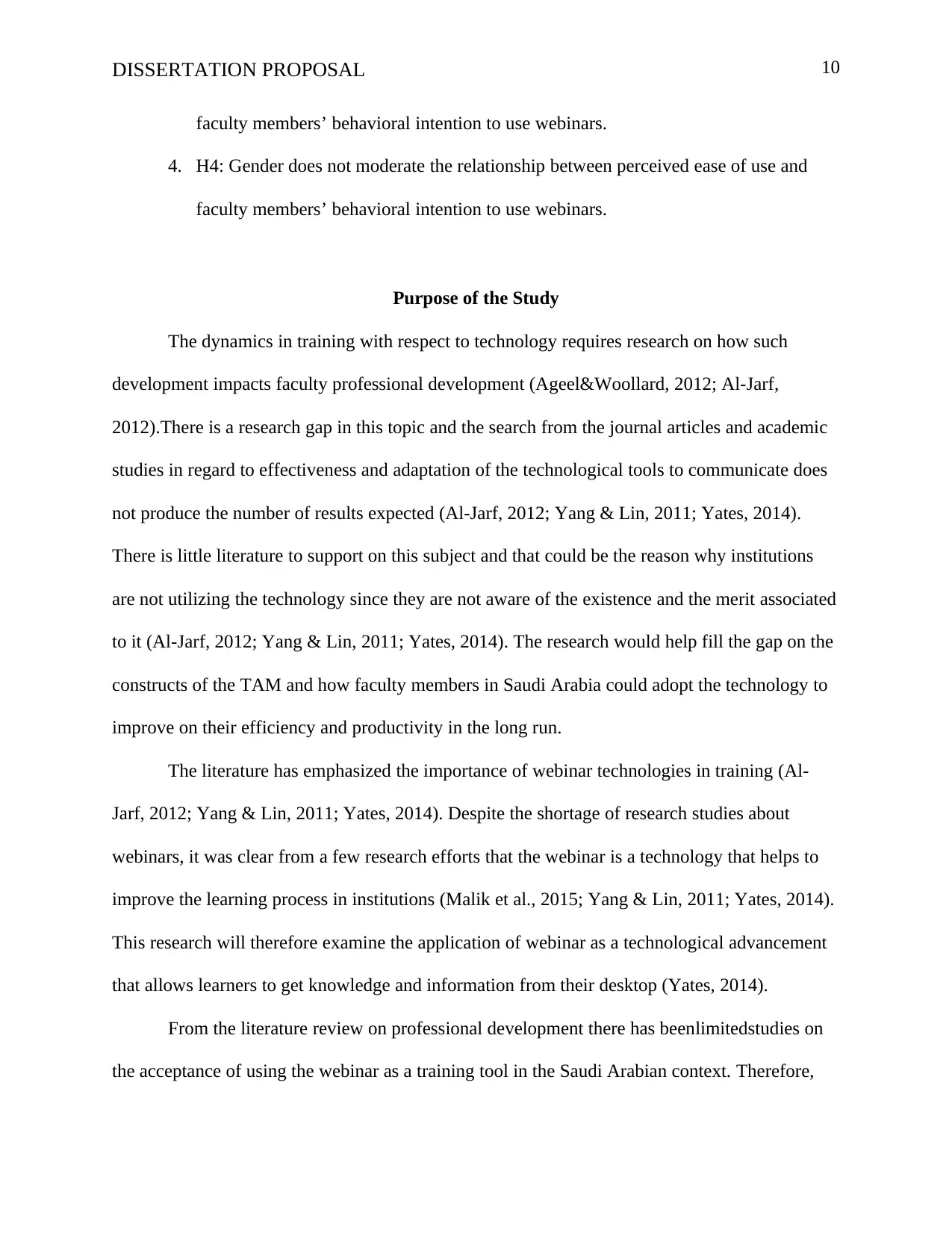
DISSERTATION PROPOSAL
faculty members’ behavioral intention to use webinars.
4. H4: Gender does not moderate the relationship between perceived ease of use and
faculty members’ behavioral intention to use webinars.
Purpose of the Study
The dynamics in training with respect to technology requires research on how such
development impacts faculty professional development (Ageel&Woollard, 2012; Al-Jarf,
2012).There is a research gap in this topic and the search from the journal articles and academic
studies in regard to effectiveness and adaptation of the technological tools to communicate does
not produce the number of results expected (Al-Jarf, 2012; Yang & Lin, 2011; Yates, 2014).
There is little literature to support on this subject and that could be the reason why institutions
are not utilizing the technology since they are not aware of the existence and the merit associated
to it (Al-Jarf, 2012; Yang & Lin, 2011; Yates, 2014). The research would help fill the gap on the
constructs of the TAM and how faculty members in Saudi Arabia could adopt the technology to
improve on their efficiency and productivity in the long run.
The literature has emphasized the importance of webinar technologies in training (Al-
Jarf, 2012; Yang & Lin, 2011; Yates, 2014). Despite the shortage of research studies about
webinars, it was clear from a few research efforts that the webinar is a technology that helps to
improve the learning process in institutions (Malik et al., 2015; Yang & Lin, 2011; Yates, 2014).
This research will therefore examine the application of webinar as a technological advancement
that allows learners to get knowledge and information from their desktop (Yates, 2014).
From the literature review on professional development there has beenlimitedstudies on
the acceptance of using the webinar as a training tool in the Saudi Arabian context. Therefore,
10
faculty members’ behavioral intention to use webinars.
4. H4: Gender does not moderate the relationship between perceived ease of use and
faculty members’ behavioral intention to use webinars.
Purpose of the Study
The dynamics in training with respect to technology requires research on how such
development impacts faculty professional development (Ageel&Woollard, 2012; Al-Jarf,
2012).There is a research gap in this topic and the search from the journal articles and academic
studies in regard to effectiveness and adaptation of the technological tools to communicate does
not produce the number of results expected (Al-Jarf, 2012; Yang & Lin, 2011; Yates, 2014).
There is little literature to support on this subject and that could be the reason why institutions
are not utilizing the technology since they are not aware of the existence and the merit associated
to it (Al-Jarf, 2012; Yang & Lin, 2011; Yates, 2014). The research would help fill the gap on the
constructs of the TAM and how faculty members in Saudi Arabia could adopt the technology to
improve on their efficiency and productivity in the long run.
The literature has emphasized the importance of webinar technologies in training (Al-
Jarf, 2012; Yang & Lin, 2011; Yates, 2014). Despite the shortage of research studies about
webinars, it was clear from a few research efforts that the webinar is a technology that helps to
improve the learning process in institutions (Malik et al., 2015; Yang & Lin, 2011; Yates, 2014).
This research will therefore examine the application of webinar as a technological advancement
that allows learners to get knowledge and information from their desktop (Yates, 2014).
From the literature review on professional development there has beenlimitedstudies on
the acceptance of using the webinar as a training tool in the Saudi Arabian context. Therefore,
10
Secure Best Marks with AI Grader
Need help grading? Try our AI Grader for instant feedback on your assignments.
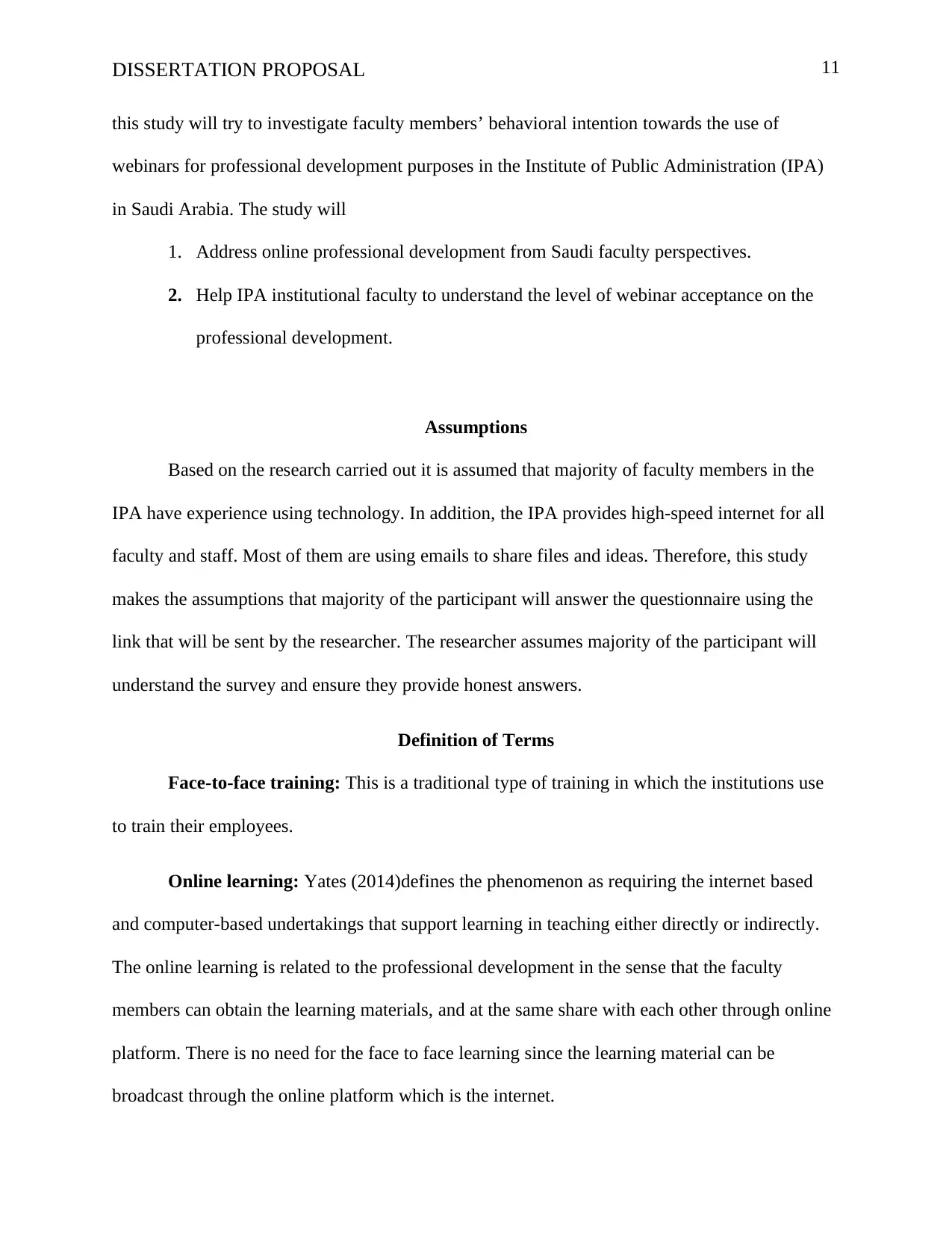
DISSERTATION PROPOSAL
this study will try to investigate faculty members’ behavioral intention towards the use of
webinars for professional development purposes in the Institute of Public Administration (IPA)
in Saudi Arabia. The study will
1. Address online professional development from Saudi faculty perspectives.
2. Help IPA institutional faculty to understand the level of webinar acceptance on the
professional development.
Assumptions
Based on the research carried out it is assumed that majority of faculty members in the
IPA have experience using technology. In addition, the IPA provides high-speed internet for all
faculty and staff. Most of them are using emails to share files and ideas. Therefore, this study
makes the assumptions that majority of the participant will answer the questionnaire using the
link that will be sent by the researcher. The researcher assumes majority of the participant will
understand the survey and ensure they provide honest answers.
Definition of Terms
Face-to-face training: This is a traditional type of training in which the institutions use
to train their employees.
Online learning: Yates (2014)defines the phenomenon as requiring the internet based
and computer-based undertakings that support learning in teaching either directly or indirectly.
The online learning is related to the professional development in the sense that the faculty
members can obtain the learning materials, and at the same share with each other through online
platform. There is no need for the face to face learning since the learning material can be
broadcast through the online platform which is the internet.
11
this study will try to investigate faculty members’ behavioral intention towards the use of
webinars for professional development purposes in the Institute of Public Administration (IPA)
in Saudi Arabia. The study will
1. Address online professional development from Saudi faculty perspectives.
2. Help IPA institutional faculty to understand the level of webinar acceptance on the
professional development.
Assumptions
Based on the research carried out it is assumed that majority of faculty members in the
IPA have experience using technology. In addition, the IPA provides high-speed internet for all
faculty and staff. Most of them are using emails to share files and ideas. Therefore, this study
makes the assumptions that majority of the participant will answer the questionnaire using the
link that will be sent by the researcher. The researcher assumes majority of the participant will
understand the survey and ensure they provide honest answers.
Definition of Terms
Face-to-face training: This is a traditional type of training in which the institutions use
to train their employees.
Online learning: Yates (2014)defines the phenomenon as requiring the internet based
and computer-based undertakings that support learning in teaching either directly or indirectly.
The online learning is related to the professional development in the sense that the faculty
members can obtain the learning materials, and at the same share with each other through online
platform. There is no need for the face to face learning since the learning material can be
broadcast through the online platform which is the internet.
11
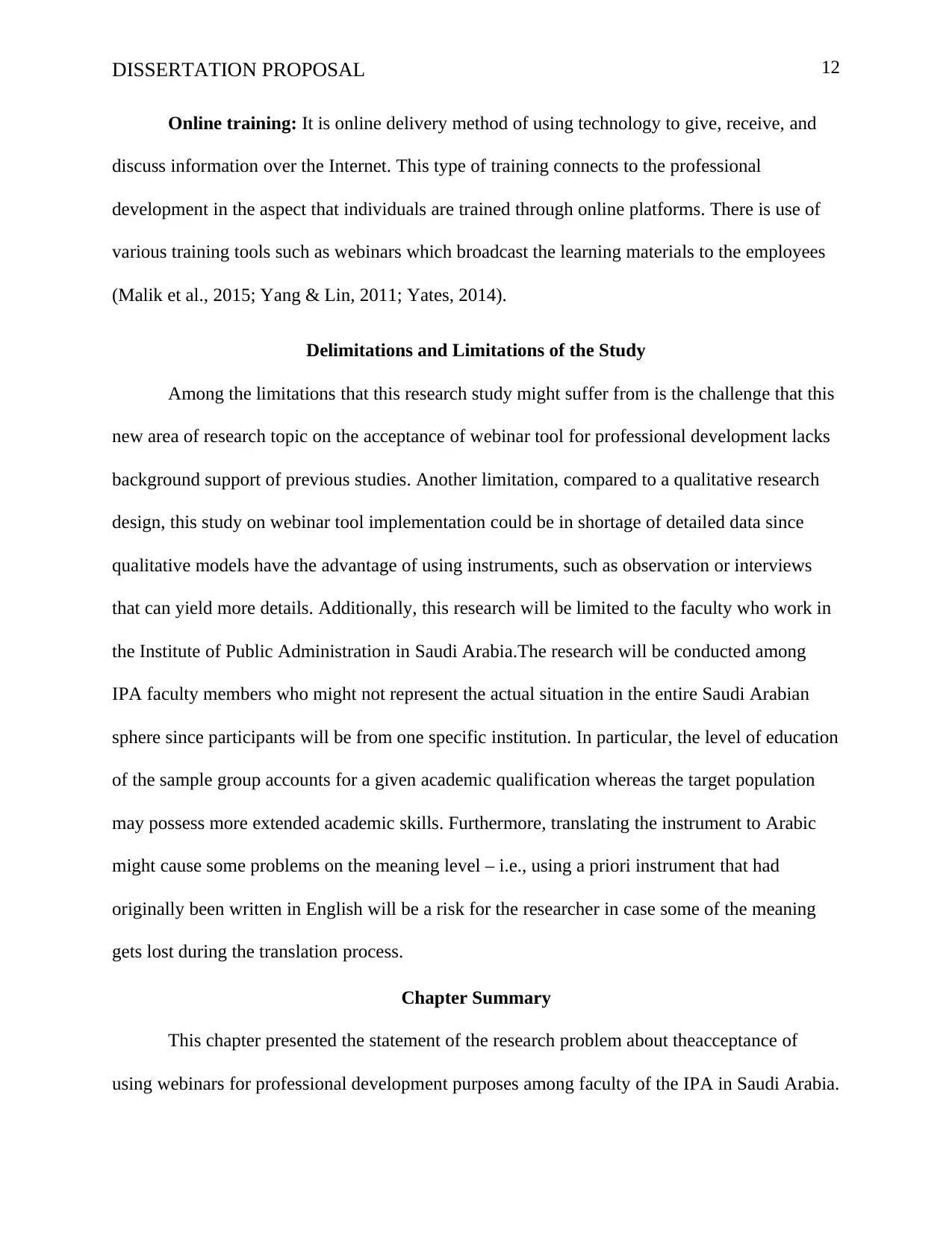
DISSERTATION PROPOSAL
Online training: It is online delivery method of using technology to give, receive, and
discuss information over the Internet. This type of training connects to the professional
development in the aspect that individuals are trained through online platforms. There is use of
various training tools such as webinars which broadcast the learning materials to the employees
(Malik et al., 2015; Yang & Lin, 2011; Yates, 2014).
Delimitations and Limitations of the Study
Among the limitations that this research study might suffer from is the challenge that this
new area of research topic on the acceptance of webinar tool for professional development lacks
background support of previous studies. Another limitation, compared to a qualitative research
design, this study on webinar tool implementation could be in shortage of detailed data since
qualitative models have the advantage of using instruments, such as observation or interviews
that can yield more details. Additionally, this research will be limited to the faculty who work in
the Institute of Public Administration in Saudi Arabia.The research will be conducted among
IPA faculty members who might not represent the actual situation in the entire Saudi Arabian
sphere since participants will be from one specific institution. In particular, the level of education
of the sample group accounts for a given academic qualification whereas the target population
may possess more extended academic skills. Furthermore, translating the instrument to Arabic
might cause some problems on the meaning level – i.e., using a priori instrument that had
originally been written in English will be a risk for the researcher in case some of the meaning
gets lost during the translation process.
Chapter Summary
This chapter presented the statement of the research problem about theacceptance of
using webinars for professional development purposes among faculty of the IPA in Saudi Arabia.
12
Online training: It is online delivery method of using technology to give, receive, and
discuss information over the Internet. This type of training connects to the professional
development in the aspect that individuals are trained through online platforms. There is use of
various training tools such as webinars which broadcast the learning materials to the employees
(Malik et al., 2015; Yang & Lin, 2011; Yates, 2014).
Delimitations and Limitations of the Study
Among the limitations that this research study might suffer from is the challenge that this
new area of research topic on the acceptance of webinar tool for professional development lacks
background support of previous studies. Another limitation, compared to a qualitative research
design, this study on webinar tool implementation could be in shortage of detailed data since
qualitative models have the advantage of using instruments, such as observation or interviews
that can yield more details. Additionally, this research will be limited to the faculty who work in
the Institute of Public Administration in Saudi Arabia.The research will be conducted among
IPA faculty members who might not represent the actual situation in the entire Saudi Arabian
sphere since participants will be from one specific institution. In particular, the level of education
of the sample group accounts for a given academic qualification whereas the target population
may possess more extended academic skills. Furthermore, translating the instrument to Arabic
might cause some problems on the meaning level – i.e., using a priori instrument that had
originally been written in English will be a risk for the researcher in case some of the meaning
gets lost during the translation process.
Chapter Summary
This chapter presented the statement of the research problem about theacceptance of
using webinars for professional development purposes among faculty of the IPA in Saudi Arabia.
12

DISSERTATION PROPOSAL
The study will use Technology Acceptance Model (TAM) as a theoretical framework to
determine the level of webinars acceptance for professional development.
13
The study will use Technology Acceptance Model (TAM) as a theoretical framework to
determine the level of webinars acceptance for professional development.
13
1 out of 13
Related Documents
Your All-in-One AI-Powered Toolkit for Academic Success.
+13062052269
info@desklib.com
Available 24*7 on WhatsApp / Email
![[object Object]](/_next/static/media/star-bottom.7253800d.svg)
Unlock your academic potential
© 2024 | Zucol Services PVT LTD | All rights reserved.





